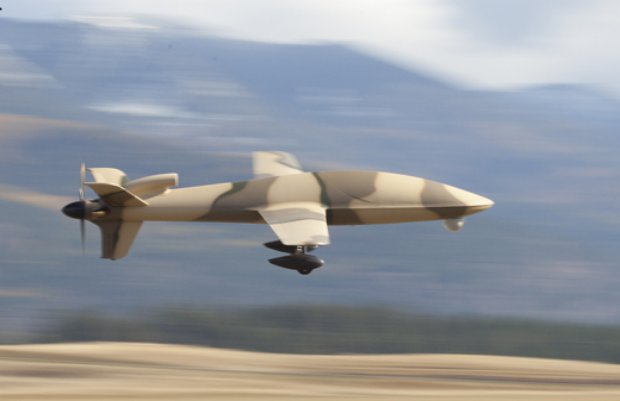The Center for Remote Integration in Montana hosted a flight demonstration of the Sandstorm UAS on a remote airstrip south of Columbia Falls on Tuesday. This was the second flight demonstration of the aircraft, after that in Oklahoma in August.
About 45 people were on hand to witness the flight, including officials with local industry, political leaders and a representative from the FAA. The unmanned aircraft, with a 15-foot wingspan and an 8-foot fuselage, took off and landed smoothly with pilot Don Bintz flying at times via the Internet and pilot Justin Sands flying it with a radio-control handset. “We’ve flown this plane from 1,300 miles away,” said Bintz, who has remotely controlled the Sandstorm from Las Vegas over the Internet.
What’s significant is that a Sandstorm aircraft recently received an experimental Airworthiness Certificate from the Federal Aviation Administration, allowing it to be flown solely through the Internet and outside radio control rules that involve a 400-foot flight ceiling.
The tail number “N44IKS” on the experimental aircraft is a “huge milestone” for the development and testing of unmanned aircraft in Montana, a state with unencumbered airspace and a unique diversity of terrain and climate, said state Sen. Ryan Zinke of Whitefish, a director of the Center for Remote Integration.
The Hays Military Operations Area outside Great Falls is by itself nearly the size of the Florida peninsula, and Sen. Max Baucus, D-Mont., is pushing for legislation that would pressure the FAA to fast-track approval of unmanned aircraft to be flown outside of military air space in Montana. “There is no better place in the lower 48 states to test and develop these platforms,” Zinke said.
Zinke and his partners envision an evolving industry that will apply military aircraft technology to commercial uses. A company called Unmanned Systems Inc. is producing the Sandstorm aircraft in a facility near Glacier Park International Airport with about five employees, and the airstrip and hangar off Middle Road south of Columbia Falls are used for research and development, said Paul Beard, one of three full-scale aircraft and radio-control pilots involved with the project.
While development of the Sandstorm has been under way for about five years, actual production started about two years ago with the first being completed a year ago. Within a year, the company expects to have completed a total of about 10 aircraft.
Zinke, a former Navy SEAL Team 6 commander, said unmanned aircraft have changed military aviation forever, and the next step is applying that transformative technology to commercial uses. “These aircraft will transition from today’s military-centric role to one of performing cost-effective civilian applications such farming, wildlife management and wildfire command and control,” he said.
And doing so will involve an integration of specialized Montana companies that complement one another, he said, citing cooperative efforts with Nomad Global Communications Solutions, a company based south of Columbia Falls that manufactures mobile vehicles outfitted with information technology systems.
The company has produced vehicles for the military and recently shipped the last of 15 disaster response vehicles to the U.S. Army Corps of Engineers. “This is definitely our field of work,” said Levi Blasdel, a Nomad representative who watched Tuesday’s demonstration flights.
Zinke described how the Sandstorm aircraft could be used as an eye in the sky on a wildfire, providing information on crew and equipment locations and hot spots on the fire perimeter, all integrated with three-dimensional mapping in a command vehicle. The Center for Remote Integration is aimed at coordinating the talents of Montana companies like NOMAD and Unmanned Systems Inc., Zinke said. “We want to bring in industries that are evolving industries.”
Source: Daily Interlake

